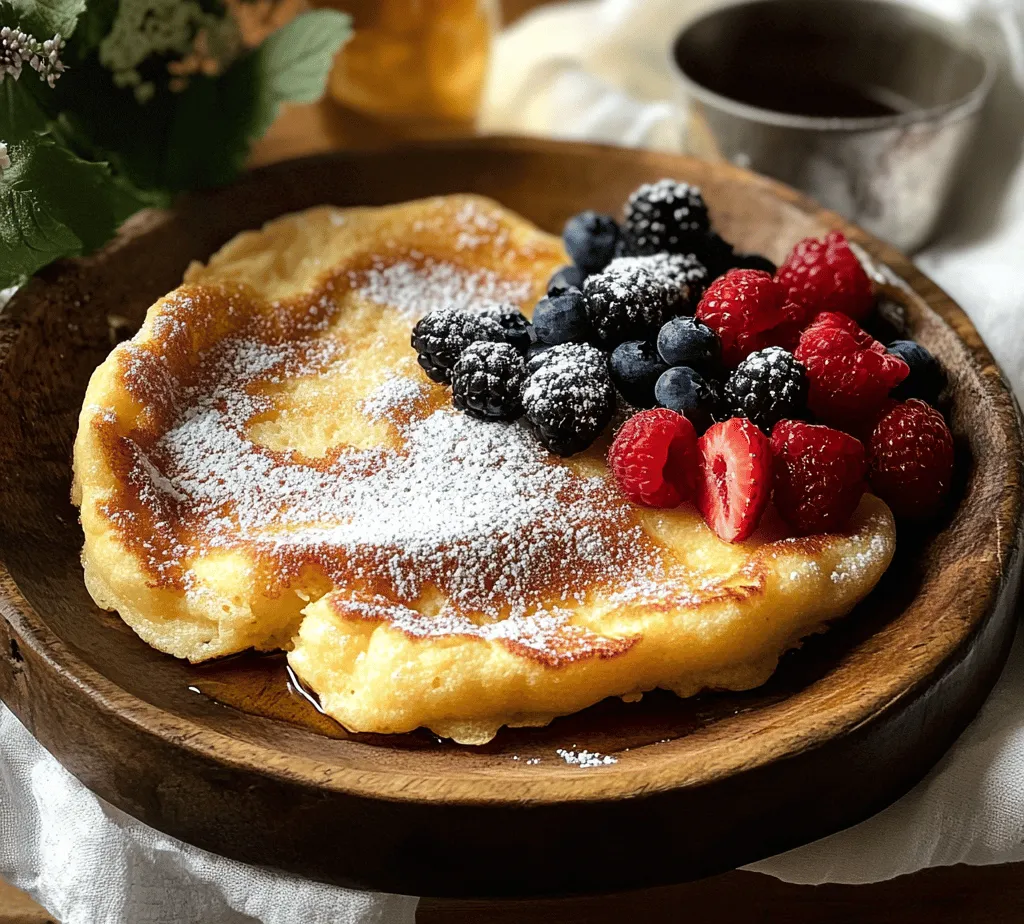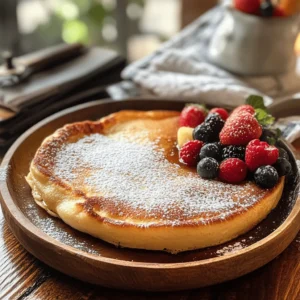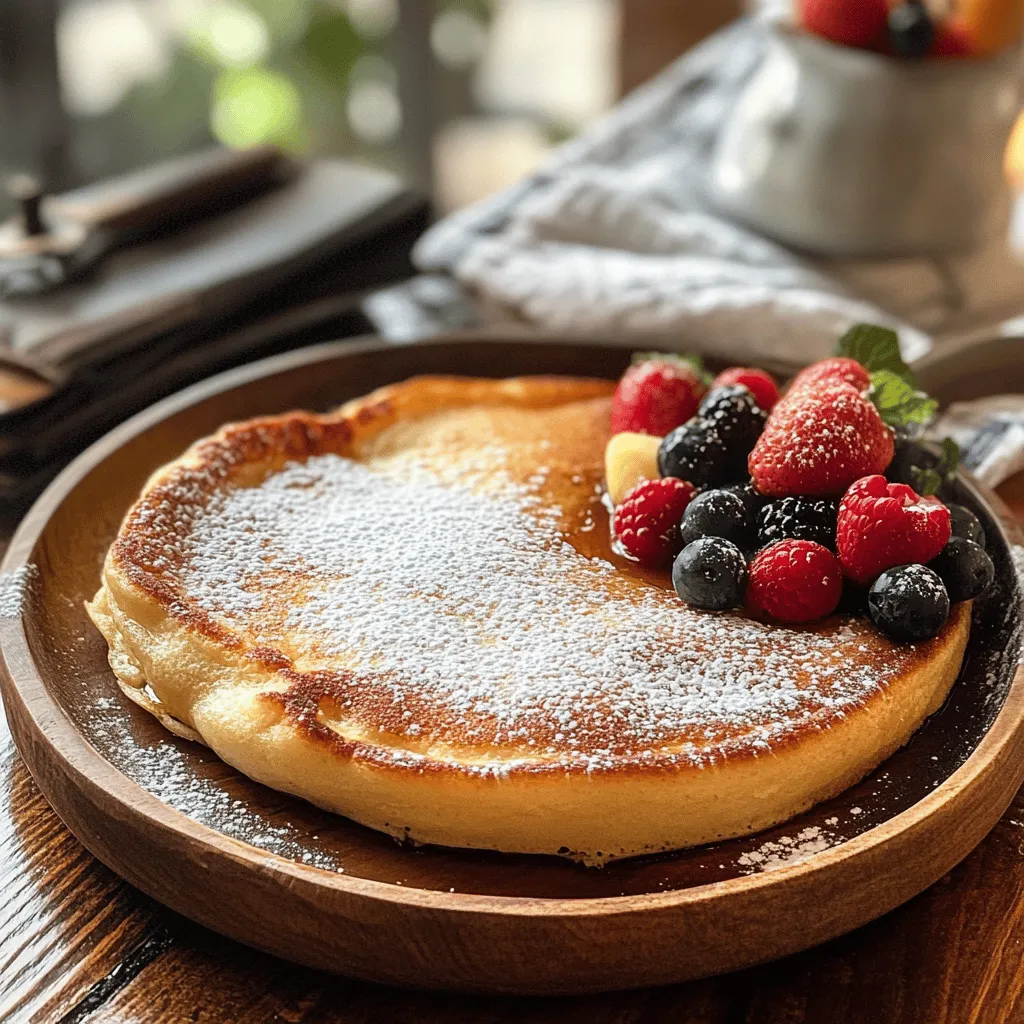Introduction
Imagine waking up to a breakfast that feels like a special occasion, even on a regular weekday. Baked German pancakes, known for their unique texture and delightful flavor, provide just that experience. Unlike traditional pancakes that are cooked individually on a griddle, these fluffy German clouds are baked in the oven, creating a light and airy dish that puffs up beautifully, resembling a golden-brown soufflé.
The simplicity of preparation is one of the many reasons this dish has gained popularity. With just a few basic ingredients and minimal effort, you can whip up a stunning pancake that will impress family and friends alike. It’s perfect for lazy Sunday brunches, holiday breakfasts, or any time you want to treat yourself to something special without spending hours in the kitchen. This baked pancake is not only visually stunning but also incredibly versatile, making it easy to adapt to various tastes and preferences.
In this article, we will delve into the origins of baked German pancakes, the essential ingredients that make them irresistible, and the detailed steps to perfect this delightful dish. Whether you’re a seasoned chef or a novice in the kitchen, this recipe will guide you through creating your very own fluffy German clouds.
Understanding the Baked German Pancake
Baked German pancakes, often referred to as Dutch babies, have an intriguing history that dates back to the early 1900s. Their origins can be traced to German immigrants who brought their culinary traditions to America. The name “Dutch baby” is believed to be a playful misnomer, stemming from the German word “Deutsch,” which means German. Over time, this dish has transcended its humble beginnings to become a beloved breakfast staple in many households across the United States and beyond.
What sets baked German pancakes apart from their traditional counterparts is their method of preparation. Instead of being flipped on a griddle, the batter is poured into a hot, buttered skillet and baked in the oven. This technique allows the pancake to rise dramatically, creating a light and fluffy texture that is hard to resist. When it comes out of the oven, the edges are crispy, while the center remains soft and custardy, making each bite a delightful experience.
The cultural significance of baked German pancakes can be seen in the various ways they are enjoyed around the world. In Germany, they are often served as a sweet breakfast dish, topped with powdered sugar and fresh fruit. In contrast, American versions may include a wide range of toppings, from maple syrup and whipped cream to savory ingredients like cheese and herbs. The versatility of this dish is part of its charm, allowing each cook to put their own spin on it based on personal preferences or seasonal ingredients.
Ingredients for Fluffy German Clouds
Creating the perfect baked German pancake requires just a handful of ingredients, each playing a crucial role in achieving that signature fluffy texture and rich flavor. Below is a comprehensive list of what you’ll need, along with the significance of each ingredient:
– Eggs: The foundation for fluffiness, eggs provide structure and stability to the pancake. They also contribute to the rich flavor and create a custard-like texture when baked.
– Whole Milk: Adds richness and moisture to the batter, ensuring the pancake stays tender and soft. The fat content in whole milk enhances the overall flavor and mouthfeel.
– All-Purpose Flour: This ingredient creates structure in the pancake. It helps to bind the ingredients together while allowing for a light, airy texture.
– Salt: A small amount of salt enhances the pancake’s flavor, balancing the sweetness and bringing out the richness of the other ingredients.
– Vanilla Extract: Adds a delightful sweetness and aroma, elevating the overall flavor profile of the pancake. It complements the other ingredients beautifully.
– Unsalted Butter: Essential for creating a golden crust, melted butter is used to coat the skillet before pouring in the batter. It also adds richness to the flavor.
– Powdered Sugar: This is typically used for dusting on top of the finished pancake, providing a sweet finish that contrasts nicely with the savory notes.
– Fresh Lemon Juice or Syrup: A squeeze of fresh lemon juice can balance the sweetness and add a refreshing zing, while syrup can provide that classic sweet touch.
– Optional Toppings: One of the best aspects of baked German pancakes is their versatility. You can top them with a variety of ingredients, such as fresh fruits (like berries, bananas, or apples), nuts for added crunch, or whipped cream for a decadent touch. The options are endless and allow for creativity based on your preferences and what you have on hand.
Step-by-Step Instructions for Perfecting the Pancake
Now that you have a solid understanding of the ingredients needed for your fluffy German clouds, it’s time to dive into the step-by-step process of making this delightful baked pancake. Following these instructions closely will ensure that you achieve the perfect rise and texture, resulting in a dish that is sure to impress.
Step 1: Preheat the Oven
Begin by preheating your oven to 425°F (220°C). This high temperature is crucial for creating the dramatic puff that baked German pancakes are known for.
Step 2: Prepare the Skillet
While the oven is heating, place a 10-inch cast-iron skillet or an oven-safe baking dish in the oven to heat up. This step is important because pouring the batter into a hot skillet helps it to rise properly and develop a beautifully crispy edge.
Step 3: Mix the Batter
In a mixing bowl, combine the following ingredients:
1. Eggs: Crack 4 large eggs into the bowl. Beat them until they are frothy; this incorporates air and helps with the fluffiness.
2. Milk: Add 1 cup of whole milk to the eggs. Whisk together until well combined.
3. Flour: Gradually sift in 1 cup of all-purpose flour, whisking continuously to avoid lumps. The batter should be smooth and slightly runny.
4. Salt: Add a pinch of salt to enhance the flavor.
5. Vanilla Extract: Stir in 1 teaspoon of pure vanilla extract for that lovely aroma and taste.
Step 4: Melt the Butter
Once the oven has reached the desired temperature, carefully remove the hot skillet. Add 4 tablespoons of unsalted butter to the skillet, allowing it to melt completely. Swirl the skillet around to ensure the melted butter coats the bottom and sides evenly.
Step 5: Pour in the Batter
After the butter has melted, pour the batter directly into the hot skillet. The batter should sizzle as it hits the hot surface, which is a good sign that you’re on the right track to achieving that fluffy texture.
Step 6: Bake the Pancake
Return the skillet to the oven and bake for about 20-25 minutes. Avoid opening the oven door during this time, as the sudden drop in temperature can prevent the pancake from rising properly. You’ll know it’s done when the edges are golden brown and puffed up, while the center is set.
Step 7: Serve Immediately
Once baked, remove the skillet from the oven and let it cool for a minute. Dust with powdered sugar and serve it immediately with your choice of toppings. The pancake will begin to deflate as it cools, so it’s best enjoyed fresh out of the oven.
By following these steps, you’ll have a stunning baked German pancake that is not only delicious but also a feast for the eyes. Stay tuned for the next part of this article, where we’ll explore tips for achieving the best results and address common questions about this delightful dish.

Preheating the Oven
Preheating the oven is a crucial step in baking, especially when it comes to achieving the perfect fluffy German pancake. By preheating your oven to 425°F (220°C), you ensure that the batter begins cooking immediately upon contact with the hot air, which is vital for achieving that iconic puffiness. Additionally, warming the baking dish while the oven heats up enhances the cooking process. A hot dish creates a quick sear on the edges of the batter, which not only helps the pancake rise but also gives it a beautifully golden crust.
To warm the baking dish, simply place it in the oven while it preheats. This step is essential because if the batter hits a cold dish, it can lead to a dense pancake instead of the light, airy texture you desire. Remember, patience pays off: while it might be tempting to skip this step, the results are well worth the wait.
Whisking the Batter
Next, it’s time to whisk the batter to perfection. Start by combining the eggs, milk, flour, and a pinch of salt in a mixing bowl. Use a whisk or an electric mixer to blend the ingredients until smooth and frothy. Achieving a lump-free batter is essential for the texture of your pancake. If you notice lumps forming, continue whisking until they disappear.
For an extra airy batter, consider whisking the eggs separately until they are light and frothy before adding the other ingredients. This technique introduces more air into the mixture, leading to a fluffier pancake upon baking. If you prefer a hands-off approach, a blender can also be used to mix your ingredients thoroughly—just be cautious not to over-blend.
Melting the Butter
As your batter comes together, it’s time to melt the butter. Carefully remove the hot baking dish from the oven using oven mitts (safety first!). Add the butter to the dish, allowing it to melt completely—it should bubble slightly. The melted butter not only adds rich flavor but also contributes to the pancake’s tender texture.
Be cautious while handling the hot dish, as it can be easy to accidentally burn yourself. Always ensure you’re using sturdy oven mitts and keep your hands dry to maintain grip. Pouring the batter over the melted butter creates a beautiful contrast as it cooks, allowing the edges to crisp while the center remains soft and fluffy.
Combining Ingredients
Once the butter is melted, it’s time to combine the batter and the butter. Pour the batter directly into the hot, melted butter without delay. This step is crucial; if the batter sits too long, it may lose some of its airy qualities due to the eggs settling. The immediate contact with the hot butter starts the cooking process right away, leading to that delightful puffiness you’re after.
As you pour, you’ll notice the batter will sizzle as it meets the butter—this is a good sign! It indicates that the pan is hot enough to promote that lovely rise. Do not stir the butter and batter together; simply pour and let the oven do its magic.
Baking to Perfection
Now, it’s time to bake your German pancake to perfection. Place the baking dish in the preheated oven and set a timer for about 20-25 minutes. As it bakes, you’ll witness the pancake rise dramatically, creating a stunning cloud-like appearance.
To know when your pancake is ready, look for a golden-brown color around the edges and a slightly puffed center. The pancake should be firm to the touch but still slightly jiggly in the middle—this indicates a soft, fluffy texture. Avoid opening the oven door too frequently during baking, as this can cause the pancake to deflate.
Once baked, remove the dish from the oven and allow it to cool slightly before serving. The pancake will begin to deflate as it cools, so serve it as soon as possible to enjoy its full height and fluffy texture.
Serving Suggestions
Now that your fluffy German clouds are ready to be enjoyed, consider these delightful serving suggestions to elevate the experience:
– Dusting with Powdered Sugar: A classic touch that adds a hint of sweetness and a beautiful presentation. Use a fine sieve to sprinkle powdered sugar over the pancake just before serving.
– Adding Fresh Lemon Juice or Syrup: A drizzle of fresh lemon juice balances the sweetness, enhancing the flavor profile. Alternatively, pour warm maple syrup over the pancake for a traditional accompaniment.
– Exploring Optional Toppings: Get creative with toppings! Seasonal fruits such as berries, sliced bananas, or peaches can add freshness and color to your dish. For an indulgent treat, add dollops of whipped cream or a scoop of vanilla ice cream.
– Savory Options: If you’re feeling adventurous, consider adding savory toppings such as sautéed mushrooms or crispy bacon for a delicious twist.
Nutritional Information
Understanding the nutritional content of your baked German pancake can help health-conscious readers enjoy it guilt-free. Here’s a breakdown of the nutritional information per serving (serving size: 1/4 of the pancake):
– Calories: Approximately 220
– Protein: 8g
– Carbohydrates: 24g
– Fat: 10g
– Fiber: 1g
– Sugar: 2g
In addition to being a delicious breakfast option, this pancake provides a good source of protein from the eggs and a moderate amount of carbohydrates from the flour. It also contains essential vitamins and minerals such as calcium from the milk and vitamin D if using fortified options.
Keep in mind that the nutritional values can vary based on the specific ingredients used and any additional toppings added.
Pairing Ideas
To create a well-rounded meal, consider these beverages and side dishes that complement the baked German pancake:
– Freshly Brewed Coffee or Tea: A warm cup of coffee or your favorite tea can enhance the breakfast experience, providing a comforting beverage that pairs beautifully with the pancake.
– Smoothies or Fruit Juices: A refreshing fruit smoothie or a glass of freshly squeezed orange juice can add a nutritious, fruity element to your meal.
– Sausages or Bacon: For those who enjoy a savory component, crispy bacon or breakfast sausages make an excellent side. The savory flavor contrasts nicely with the sweetness of the pancake, creating a balanced plate.
Conclusion
Making and enjoying fluffy German clouds is not just about preparing a meal; it’s about creating a delightful experience that can bring friends and family together. This versatile dish offers something for everyone, whether you enjoy it sweet or savory. With its ease of preparation and impressive presentation, it’s perfect for weekend brunches or a special breakfast treat any day of the week.
As you dive into this recipe, feel free to experiment with different toppings and flavors to make it your own. Share your experiences and variations with friends, fostering a sense of community around this delicious dish. We hope you enjoy every fluffy bite of your German pancake and create lasting memories in the kitchen!



